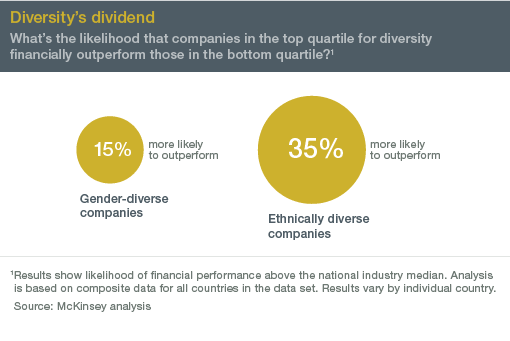How Workplaces Get Diversity Training Wrong. Companies in the top quartile for gender diversity were also 15% more likely to have returns above their industry means. Image credit: McKinsey But diversity isn't a just business play. But diversity isn't a just business play. And as more companies start to incorporate diversity programs into their training and hiring practices, many are failing to develop truly meaningful, empathetic initiatives that go beyond surface-level quotas and checkboxes. By no means does this study indicate you should abandon your company's diversity program for fear of failure. It means it's time for a more empathetic, self-aware approach to diversity -- in the workplace and beyond. He's found that cultivating empathy, rather than diversity alone, is necessary for creating real cultural changes. It has marginalized people -- period. "People are on board with that part of it: getting this new visceral experience, learning these new things," Foss says.

Workplace diversity isn’t just good for your employees’ wellbeing — it’s also good for business.
Back in 2015, a McKinsey report found that companies with management teams in the top quartile for ethnic and racial diversity were 35% more likely to have financial returns above their respective national industry medians. Companies in the top quartile for gender diversity were also 15% more likely to have returns above their industry means.

Image credit: McKinsey
But diversity isn't a just business play. It's a human play.
But diversity isn’t a just business play. It’s a human play. And as more companies start to incorporate diversity programs into their training and hiring practices, many are failing to develop truly meaningful, empathetic initiatives that go beyond surface-level quotas and checkboxes.
A recent investigation by Harvard Business Review found that some common tactics like mandatory skill assessment tests to reduce hiring bias, annual performance ratings to evaluate pay gaps, grievance systems to rehabilitate biased managers, and compulsory diversity training programs to educate employees just aren’t doing enough to bring organizations into the 21st century. In fact, some of these initiatives might even have an adverse impact on organizational health, reinforcing bias instead of alleviating its damage.
Laboratory studies show that this kind of force-feeding can activate bias rather than stamp it out.
According to sociology professors Frank Dobbin and Alexandra Kalev, “Those [diversity initiatives] are designed to preempt lawsuits by policing managers’ thoughts and actions. Yet laboratory studies show that this kind of force-feeding can activate bias rather than stamp it out. As social scientists have found, people often rebel against rules to assert their autonomy. Try to coerce me to do X, Y, or Z, and I’ll do the opposite just to prove that I’m my own person.”
By no means does…

COMMENTS